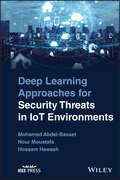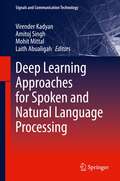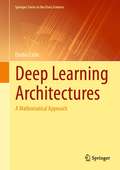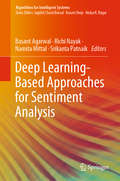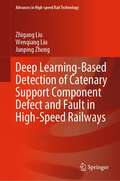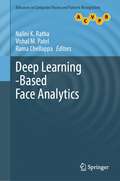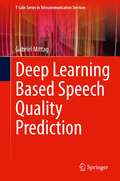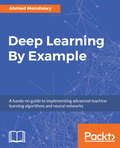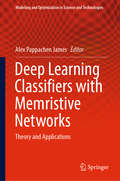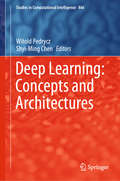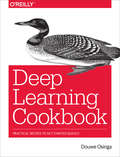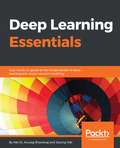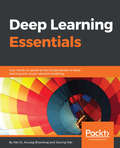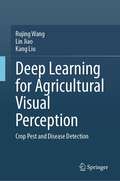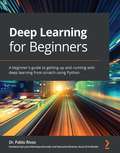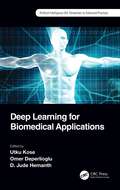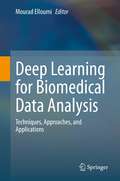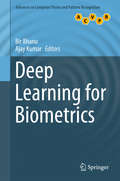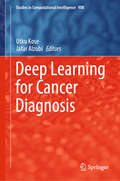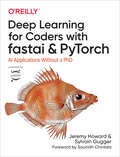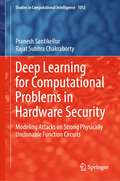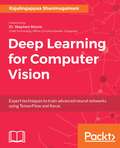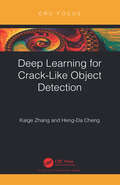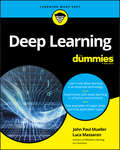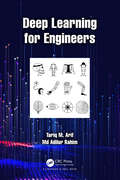- Table View
- List View
Deep Learning Approaches for Security Threats in IoT Environments
by Mohamed Abdel-Basset Nour Moustafa Hossam HawashDeep Learning Approaches for Security Threats in IoT Environments An expert discussion of the application of deep learning methods in the IoT security environment In Deep Learning Approaches for Security Threats in IoT Environments, a team of distinguished cybersecurity educators deliver an insightful and robust exploration of how to approach and measure the security of Internet-of-Things (IoT) systems and networks. In this book, readers will examine critical concepts in artificial intelligence (AI) and IoT, and apply effective strategies to help secure and protect IoT networks. The authors discuss supervised, semi-supervised, and unsupervised deep learning techniques, as well as reinforcement and federated learning methods for privacy preservation. This book applies deep learning approaches to IoT networks and solves the security problems that professionals frequently encounter when working in the field of IoT, as well as providing ways in which smart devices can solve cybersecurity issues. Readers will also get access to a companion website with PowerPoint presentations, links to supporting videos, and additional resources. They’ll also find: A thorough introduction to artificial intelligence and the Internet of Things, including key concepts like deep learning, security, and privacy Comprehensive discussions of the architectures, protocols, and standards that form the foundation of deep learning for securing modern IoT systems and networks In-depth examinations of the architectural design of cloud, fog, and edge computing networks Fulsome presentations of the security requirements, threats, and countermeasures relevant to IoT networks Perfect for professionals working in the AI, cybersecurity, and IoT industries, Deep Learning Approaches for Security Threats in IoT Environments will also earn a place in the libraries of undergraduate and graduate students studying deep learning, cybersecurity, privacy preservation, and the security of IoT networks.
Deep Learning Approaches for Spoken and Natural Language Processing (Signals and Communication Technology)
by Virender Kadyan Amitoj Singh Mohit Mittal Laith AbualigahThis book provides insights into how deep learning techniques impact language and speech processing applications. The authors discuss the promise, limits and the new challenges in deep learning. The book covers the major differences between the various applications of deep learning and the classical machine learning techniques. The main objective of the book is to present a comprehensive survey of the major applications and research oriented articles based on deep learning techniques that are focused on natural language and speech signal processing. The book is relevant to academicians, research scholars, industrial experts, scientists and post graduate students working in the field of speech signal and natural language processing and would like to add deep learning to enhance capabilities of their work.Discusses current research challenges and future perspective about how deep learning techniques can be applied to improve NLP and speech processing applications;Presents and escalates the research trends and future direction of language and speech processing;Includes theoretical research, experimental results, and applications of deep learning.
Deep Learning Architectures: A Mathematical Approach (Springer Series in the Data Sciences)
by Ovidiu CalinThis book describes how neural networks operate from the mathematical point of view. As a result, neural networks can be interpreted both as function universal approximators and information processors. The book bridges the gap between ideas and concepts of neural networks, which are used nowadays at an intuitive level, and the precise modern mathematical language, presenting the best practices of the former and enjoying the robustness and elegance of the latter.This book can be used in a graduate course in deep learning, with the first few parts being accessible to senior undergraduates. In addition, the book will be of wide interest to machine learning researchers who are interested in a theoretical understanding of the subject.
Deep Learning-Based Approaches for Sentiment Analysis (Algorithms for Intelligent Systems)
by Basant Agarwal Namita Mittal Srikanta Patnaik Richi NayakThis book covers deep-learning-based approaches for sentiment analysis, a relatively new, but fast-growing research area, which has significantly changed in the past few years. The book presents a collection of state-of-the-art approaches, focusing on the best-performing, cutting-edge solutions for the most common and difficult challenges faced in sentiment analysis research. Providing detailed explanations of the methodologies, the book is a valuable resource for researchers as well as newcomers to the field.
Deep Learning-Based Detection of Catenary Support Component Defect and Fault in High-Speed Railways (Advances in High-speed Rail Technology)
by Zhigang Liu Wenqiang Liu Junping ZhongThis book focuses on the deep learning technologies and their applications in the catenary detection of high-speed railways. As the only source of power for high-speed trains, the catenary's service performance directly affects the safe operation of high-speed railways. This book systematically shows the latest research results of catenary detection in high-speed railways, especially the detection of catenary support component defect and fault. Some methods or algorithms have been adopted in practical engineering. These methods or algorithms provide important references and help the researcher, scholar, and engineer on pantograph and catenary technology in high-speed railways. Unlike traditional detection methods of catenary support component based on image processing, some advanced methods in the deep learning field, including convolutional neural network, reinforcement learning, generative adversarial network, etc., are adopted and improved in this book. The main contents include the overview of catenary detection of electrified railways, the introduction of some advance of deep learning theories, catenary support components and their characteristics in high-speed railways, the image reprocessing of catenary support components, the positioning of catenary support components, the detection of defect and fault, the detection based on 3D point cloud, etc.
Deep Learning-Based Face Analytics (Advances in Computer Vision and Pattern Recognition)
by Nalini K. Ratha Vishal M. Patel Rama ChellappaThis book provides an overview of different deep learning-based methods for face recognition and related problems. Specifically, the authors present methods based on autoencoders, restricted Boltzmann machines, and deep convolutional neural networks for face detection, localization, tracking, recognition, etc. The authors also discuss merits and drawbacks of available approaches and identifies promising avenues of research in this rapidly evolving field. Even though there have been a number of different approaches proposed in the literature for face recognition based on deep learning methods, there is not a single book available in the literature that gives a complete overview of these methods. The proposed book captures the state of the art in face recognition using various deep learning methods, and it covers a variety of different topics related to face recognition. This book is aimed at graduate students studying electrical engineering and/or computer science. Biometrics is a course that is widely offered at both undergraduate and graduate levels at many institutions around the world: This book can be used as a textbook for teaching topics related to face recognition. In addition, the work is beneficial to practitioners in industry who are working on biometrics-related problems. The prerequisites for optimal use are the basic knowledge of pattern recognition, machine learning, probability theory, and linear algebra.
Deep Learning Based Speech Quality Prediction (T-Labs Series in Telecommunication Services)
by Gabriel MittagThis book presents how to apply recent machine learning (deep learning) methods for the task of speech quality prediction. The author shows how recent advancements in machine learning can be leveraged for the task of speech quality prediction and provides an in-depth analysis of the suitability of different deep learning architectures for this task. The author then shows how the resulting model outperforms traditional speech quality models and provides additional information about the cause of a quality impairment through the prediction of the speech quality dimensions of noisiness, coloration, discontinuity, and loudness.
Deep Learning By Example: A hands-on guide to implementing advanced machine learning algorithms and neural networks
by Ahmed MenshawyGrasp the fundamental concepts of deep learning using Tensorflow in a hands-on manner About This Book • Get a first-hand experience of the deep learning concepts and techniques with this easy-to-follow guide • Train different types of neural networks using Tensorflow for real-world problems in language processing, computer vision, transfer learning, and more • Designed for those who believe in the concept of 'learn by doing', this book is a perfect blend of theory and code examples Who This Book Is For This book targets data scientists and machine learning developers who wish to get started with deep learning. If you know what deep learning is but are not quite sure of how to use it, this book will help you as well. An understanding of statistics and data science concepts is required. Some familiarity with Python programming will also be beneficial. What You Will Learn • Understand the fundamentals of deep learning and how it is different from machine learning • Get familiarized with Tensorflow, one of the most popular libraries for advanced machine learning • Increase the predictive power of your model using feature engineering • Understand the basics of deep learning by solving a digit classification problem of MNIST • Demonstrate face generation based on the CelebA database, a promising application of generative models • Apply deep learning to other domains like language modeling, sentiment analysis, and machine translation In Detail Deep learning is a popular subset of machine learning, and it allows you to build complex models that are faster and give more accurate predictions. This book is your companion to take your first steps into the world of deep learning, with hands-on examples to boost your understanding of the topic. This book starts with a quick overview of the essential concepts of data science and machine learning which are required to get started with deep learning. It introduces you to Tensorflow, the most widely used machine learning library for training deep learning models. You will then work on your first deep learning problem by training a deep feed-forward neural network for digit classification, and move on to tackle other real-world problems in computer vision, language processing, sentiment analysis, and more. Advanced deep learning models such as generative adversarial networks and their applications are also covered in this book. By the end of this book, you will have a solid understanding of all the essential concepts in deep learning. With the help of the examples and code provided in this book, you will be equipped to train your own deep learning models with more confidence. Style and approach A step-by-step guide filled with multiple examples to help you get started with data science and deep learning.
Deep Learning Classifiers with Memristive Networks: Theory and Applications (Modeling and Optimization in Science and Technologies #14)
by Alex Pappachen JamesThis book introduces readers to the fundamentals of deep neural network architectures, with a special emphasis on memristor circuits and systems. At first, the book offers an overview of neuro-memristive systems, including memristor devices, models, and theory, as well as an introduction to deep learning neural networks such as multi-layer networks, convolution neural networks, hierarchical temporal memory, and long short term memories, and deep neuro-fuzzy networks. It then focuses on the design of these neural networks using memristor crossbar architectures in detail. The book integrates the theory with various applications of neuro-memristive circuits and systems. It provides an introductory tutorial on a range of issues in the design, evaluation techniques, and implementations of different deep neural network architectures with memristors.
Deep Learning: Concepts and Architectures (Studies in Computational Intelligence #866)
by Witold Pedrycz Shyi-Ming ChenThis book introduces readers to the fundamental concepts of deep learning and offers practical insights into how this learning paradigm supports automatic mechanisms of structural knowledge representation. It discusses a number of multilayer architectures giving rise to tangible and functionally meaningful pieces of knowledge, and shows how the structural developments have become essential to the successful delivery of competitive practical solutions to real-world problems. The book also demonstrates how the architectural developments, which arise in the setting of deep learning, support detailed learning and refinements to the system design. Featuring detailed descriptions of the current trends in the design and analysis of deep learning topologies, the book offers practical guidelines and presents competitive solutions to various areas of language modeling, graph representation, and forecasting.
Deep Learning Cookbook: Practical Recipes to Get Started Quickly
by Douwe OsingaDeep learning doesn’t have to be intimidating. Until recently, this machine-learning method required years of study, but with frameworks such as Keras and Tensorflow, software engineers without a background in machine learning can quickly enter the field. With the recipes in this cookbook, you’ll learn how to solve deep-learning problems for classifying and generating text, images, and music.Each chapter consists of several recipes needed to complete a single project, such as training a music recommending system. Author Douwe Osinga also provides a chapter with half a dozen techniques to help you if you’re stuck. Examples are written in Python with code available on GitHub as a set of Python notebooks.You’ll learn how to:Create applications that will serve real usersUse word embeddings to calculate text similarityBuild a movie recommender system based on Wikipedia linksLearn how AIs see the world by visualizing their internal stateBuild a model to suggest emojis for pieces of textReuse pretrained networks to build an inverse image search serviceCompare how GANs, autoencoders and LSTMs generate iconsDetect music styles and index song collections
Deep Learning Essentials: Your Hands-on Guide To The Fundamentals Of Deep Learning And Neural Network Modeling
by Wei DiDeep Learning is one of the trending topics in the field of Artificial Intelligence today and can be considered to be an advanced form of machine learning. This book will help you take your first steps when it comes to training efficient deep learning models, and apply them in various practical scenarios. You will model, train and deploy different kinds of neural networks such as CNN and RNN and see their applications in real-world domains.
Deep Learning Essentials: Your hands-on guide to the fundamentals of deep learning and neural network modeling
by Wei Di Anurag Bhardwaj Jianing WeiGet to grips with the essentials of deep learning by leveraging the power of Python Key Features Your one-stop solution to get started with the essentials of deep learning and neural network modeling Train different kinds of neural networks to tackle various problems in Natural Language Processing, computer vision, speech recognition, and more Covers popular Python libraries such as Tensorflow, Keras, and more, along with tips on training, deploying and optimizing your deep learning models in the best possible manner Book Description Deep Learning a trending topic in the field of Artificial Intelligence today and can be considered to be an advanced form of machine learning, which is quite tricky to master. This book will help you take your first steps in training efficient deep learning models and applying them in various practical scenarios. You will model, train, and deploy different kinds of neural networks such as Convolutional Neural Network, Recurrent Neural Network, and will see some of their applications in real-world domains including computer vision, natural language processing, speech recognition, and so on. You will build practical projects such as chatbots, implement reinforcement learning to build smart games, and develop expert systems for image captioning and processing. Popular Python library such as TensorFlow is used in this book to build the models. This book also covers solutions for different problems you might come across while training models, such as noisy datasets, small datasets, and more. This book does not assume any prior knowledge of deep learning. By the end of this book, you will have a firm understanding of the basics of deep learning and neural network modeling, along with their practical applications. What you will learn Get to grips with the core concepts of deep learning and neural networks Set up deep learning library such as TensorFlow Fine-tune your deep learning models for NLP and Computer Vision applications Unify different information sources, such as images, text, and speech through deep learning Optimize and fine-tune your deep learning models for better performance Train a deep reinforcement learning model that plays a game better than humans Learn how to make your models get the best out of your GPU or CPUWho this book is for Aspiring data scientists and machine learning experts who have limited or no exposure to deep learning will find this book to be very useful. If you are looking for a resource that gets you up and running with the fundamentals of deep learning and neural networks, this book is for you. As the models in the book are trained using the popular Python-based libraries such as Tensorflow and Keras, it would be useful to have sound programming knowledge of Python.
Deep Learning for Agricultural Visual Perception: Crop Pest and Disease Detection
by Rujing Wang Lin Jiao Kang LiuThis monograph provides a detailed and systematic introduction to the application of deep learning technology in the intelligent monitoring of crop diseases and pests. Taking 24 types of crop pests, wheat aphids, and wheat diseases with complex backgrounds as examples, a large-scale crop pest and disease dataset was constructed to provide necessary data support for the deep learning module. Various schemes for identifying and detecting large-scale crop diseases and pests based on deep convolutional neural network technology have also been proposed. This book can be used as a reference for teachers and students majoring in agriculture, computer science, artificial intelligence, intelligent science and technology, and other related fields in higher education institutions. It can also be used as a reference book for researchers in fields such as image processing technology, intelligent manufacturing, and high-tech applications.
Deep Learning for Beginners: A beginner's guide to getting up and running with deep learning from scratch using Python
by Dr. Pablo Rivas Laura MontoyaImplementing supervised, unsupervised, and generative deep learning (DL) models using Keras and Dopamine over TensorFlow. Key Features Understand the fundamental machine learning concepts useful in deep learning Learn the underlying mathematical concepts as you implement deep learning models from scratch Explore easy-to-understand examples and use cases that will help you build a solid foundation in DL Book Description With information on the web exponentially increasing, it has become more difficult than ever to navigate through everything to find reliable content that will help you get started with deep learning. This book is designed to help you if you're a beginner looking to work on deep learning and build deep learning models from scratch, and already have the basic mathematical and programming knowledge required to get started. The book begins with a basic overview of machine learning, guiding you through setting up popular Python frameworks. You will also understand how to prepare data by cleaning and preprocessing it for deep learning, and gradually go on to explore neural networks. A dedicated section will give you insights into the working of neural networks by helping you get hands-on with training single and multiple layers of neurons. Later, you will cover popular neural network architectures such as CNNs, RNNs, AEs, VAEs, and GANs with the help of simple examples, and you will even build models from scratch. At the end of each chapter, you will find a question and answer section to help you test what you've learned through the course of the book. By the end of this book, you'll be well-versed with deep learning concepts and have the knowledge you need to use specific algorithms with various tools for different tasks. What you will learn Implement RNNs and Long short-term memory for image classification and Natural Language Processing tasks Explore the role of CNNs in computer vision and signal processing Understand the ethical implications of deep learning modeling Understand the mathematical terminology associated with deep learning Code a GAN and a VAE to generate images from a learned latent space Implement visualization techniques to compare AEs and VAEs Who this book is for This book is for aspiring data scientists and deep learning engineers who want to get started with the fundamentals of deep learning and neural networks. Although no prior knowledge of deep learning or machine learning is required, familiarity with linear algebra and Python programming is necessary to get started.
Deep Learning for Biomedical Applications (Artificial Intelligence (AI): Elementary to Advanced Practices)
by Utku Kose Omer Deperlioglu D. Jude HemanthThis book is a detailed reference on biomedical applications using Deep Learning. Because Deep Learning is an important actor shaping the future of Artificial Intelligence, its specific and innovative solutions for both medical and biomedical are very critical. This book provides a recent view of research works on essential, and advanced topics. The book offers detailed information on the application of Deep Learning for solving biomedical problems. It focuses on different types of data (i.e. raw data, signal-time series, medical images) to enable readers to understand the effectiveness and the potential. It includes topics such as disease diagnosis, image processing perspectives, and even genomics. It takes the reader through different sides of Deep Learning oriented solutions. The specific and innovative solutions covered in this book for both medical and biomedical applications are critical to scientists, researchers, practitioners, professionals, and educations who are working in the context of the topics.
Deep Learning for Biomedical Data Analysis: Techniques, Approaches, and Applications
by Mourad ElloumiThis book is the first overview on Deep Learning (DL) for biomedical data analysis. It surveys the most recent techniques and approaches in this field, with both a broad coverage and enough depth to be of practical use to working professionals. This book offers enough fundamental and technical information on these techniques, approaches and the related problems without overcrowding the reader's head. It presents the results of the latest investigations in the field of DL for biomedical data analysis. The techniques and approaches presented in this book deal with the most important and/or the newest topics encountered in this field. They combine fundamental theory of Artificial Intelligence (AI), Machine Learning (ML) and DL with practical applications in Biology and Medicine. Certainly, the list of topics covered in this book is not exhaustive but these topics will shed light on the implications of the presented techniques and approaches on other topics in biomedical data analysis. The book finds a balance between theoretical and practical coverage of a wide range of issues in the field of biomedical data analysis, thanks to DL. The few published books on DL for biomedical data analysis either focus on specific topics or lack technical depth. The chapters presented in this book were selected for quality and relevance. The book also presents experiments that provide qualitative and quantitative overviews in the field of biomedical data analysis. The reader will require some familiarity with AI, ML and DL and will learn about techniques and approaches that deal with the most important and/or the newest topics encountered in the field of DL for biomedical data analysis. He/she will discover both the fundamentals behind DL techniques and approaches, and their applications on biomedical data. This book can also serve as a reference book for graduate courses in Bioinformatics, AI, ML and DL. The book aims not only at professional researchers and practitioners but also graduate students, senior undergraduate students and young researchers. This book will certainly show the way to new techniques and approaches to make new discoveries.
Deep Learning for Biometrics (Advances in Computer Vision and Pattern Recognition)
by Bir Bhanu Ajay KumarThis timely text/reference presents a broad overview of advanced deep learning architectures for learning effective feature representation for perceptual and biometrics-related tasks. The text offers a showcase of cutting-edge research on the use of convolutional neural networks (CNN) in face, iris, fingerprint, and vascular biometric systems, in addition to surveillance systems that use soft biometrics. Issues of biometrics security are also examined. Topics and features: addresses the application of deep learning to enhance the performance of biometrics identification across a wide range of different biometrics modalities; revisits deep learning for face biometrics, offering insights from neuroimaging, and provides comparison with popular CNN-based architectures for face recognition; examines deep learning for state-of-the-art latent fingerprint and finger-vein recognition, as well as iris recognition; discusses deep learning for soft biometrics, including approaches for gesture-based identification, gender classification, and tattoo recognition; investigates deep learning for biometrics security, covering biometrics template protection methods, and liveness detection to protect against fake biometrics samples; presents contributions from a global selection of pre-eminent experts in the field representing academia, industry and government laboratories. Providing both an accessible introduction to the practical applications of deep learning in biometrics, and a comprehensive coverage of the entire spectrum of biometric modalities, this authoritative volume will be of great interest to all researchers, practitioners and students involved in related areas of computer vision, pattern recognition and machine learning.
Deep Learning for Cancer Diagnosis (Studies in Computational Intelligence #908)
by Utku Kose Jafar AlzubiThis book explores various applications of deep learning to the diagnosis of cancer,while also outlining the future face of deep learning-assisted cancer diagnostics. As is commonly known, artificial intelligence has paved the way for countless new solutions in the field of medicine. In this context, deep learning is a recent and remarkable sub-field, which can effectively cope with huge amounts of data and deliver more accurate results. As a vital research area, medical diagnosis is among those in which deep learning-oriented solutions are often employed.Accordingly, the objective of this book is to highlight recent advanced applications of deep learning for diagnosing different types of cancer. The target audience includes scientists, experts, MSc and PhD students, postdocs, and anyone interested in the subjects discussed. The book can be used as a reference work to support courses on artificial intelligence, medical and biomedicaleducation.
Deep Learning for Coders with fastai and PyTorch: Ai Applications Without A Phd
by Jeremy Howard Sylvain GuggerDeep learning is often viewed as the exclusive domain of math PhDs and big tech companies. But as this hands-on guide demonstrates, programmers comfortable with Python can achieve impressive results in deep learning with little math background, small amounts of data, and minimal code. How? With fastai, the first library to provide a consistent interface to the most frequently used deep learning applications.Authors Jeremy Howard and Sylvain Gugger, the creators of fastai, show you how to train a model on a wide range of tasks using fastai and PyTorch. You’ll also dive progressively further into deep learning theory to gain a complete understanding of the algorithms behind the scenes.Train models in computer vision, natural language processing, tabular data, and collaborative filteringLearn the latest deep learning techniques that matter most in practiceImprove accuracy, speed, and reliability by understanding how deep learning models workDiscover how to turn your models into web applicationsImplement deep learning algorithms from scratchConsider the ethical implications of your workGain insight from the foreword by PyTorch cofounder, Soumith Chintala
Deep Learning for Computational Problems in Hardware Security: Modeling Attacks on Strong Physically Unclonable Function Circuits (Studies in Computational Intelligence #1052)
by Pranesh Santikellur Rajat Subhra ChakrabortyThe book discusses a broad overview of traditional machine learning methods and state-of-the-art deep learning practices for hardware security applications, in particular the techniques of launching potent "modeling attacks" on Physically Unclonable Function (PUF) circuits, which are promising hardware security primitives. The volume is self-contained and includes a comprehensive background on PUF circuits, and the necessary mathematical foundation of traditional and advanced machine learning techniques such as support vector machines, logistic regression, neural networks, and deep learning. This book can be used as a self-learning resource for researchers and practitioners of hardware security, and will also be suitable for graduate-level courses on hardware security and application of machine learning in hardware security. A stand-out feature of the book is the availability of reference software code and datasets to replicate the experiments described in the book.
Deep Learning for Computer Vision: Expert techniques to train advanced neural networks using TensorFlow and Keras
by Nishanth Koganti Stephen Maurice Moore Abdul Ghani Abdul Rahman Rajalingappaa ShanmugamaniLearn how to model and train advanced neural networks to implement a variety of Computer Vision tasks Key Features Train different kinds of deep learning model from scratch to solve specific problems in Computer Vision Combine the power of Python, Keras, and TensorFlow to build deep learning models for object detection, image classification, similarity learning, image captioning, and more Includes tips on optimizing and improving the performance of your models under various constraints Book Description Deep learning has shown its power in several application areas of Artificial Intelligence, especially in Computer Vision. Computer Vision is the science of understanding and manipulating images, and finds enormous applications in the areas of robotics, automation, and so on. This book will also show you, with practical examples, how to develop Computer Vision applications by leveraging the power of deep learning. In this book, you will learn different techniques related to object classification, object detection, image segmentation, captioning, image generation, face analysis, and more. You will also explore their applications using popular Python libraries such as TensorFlow and Keras. This book will help you master state-of-the-art, deep learning algorithms and their implementation. What you will learn Set up an environment for deep learning with Python, TensorFlow, and Keras Define and train a model for image and video classification Use features from a pre-trained Convolutional Neural Network model for image retrieval Understand and implement object detection using the real-world Pedestrian Detection scenario Learn about various problems in image captioning and how to overcome them by training images and text together Implement similarity matching and train a model for face recognition Understand the concept of generative models and use them for image generation Deploy your deep learning models and optimize them for high performance Who this book is for This book is targeted at data scientists and Computer Vision practitioners who wish to apply the concepts of Deep Learning to overcome any problem related to Computer Vision. A basic knowledge of programming in Python—and some understanding of machine learning concepts—is required to get the best out of this book.
Deep Learning for Crack-Like Object Detection
by Kaige Zhang Heng-Da ChengComputer vision-based crack-like object detection has many useful applications, such as inspecting/monitoring pavement surface, underground pipeline, bridge cracks, railway tracks etc. However, in most contexts, cracks appear as thin, irregular long-narrow objects, and often are buried in complex, textured background with high diversity which make the crack detection very challenging. During the past a few years, deep learning technique has achieved great success and has been utilized for solving a variety of object detection problems. This book discusses crack-like object detection problem comprehensively. It starts by discussing traditional image processing approaches for solving this problem, and then introduces deep learning-based methods. It provides a detailed review of object detection problems and focuses on the most challenging problem, crack-like object detection, to dig deep into the deep learning method. It includes examples of real-world problems, which are easy to understand and could be a good tutorial for introducing computer vision and machine learning.
Deep Learning For Dummies
by John Paul Mueller Luca MassaronTake a deep dive into deep learning Deep learning provides the means for discerning patterns in the data that drive online business and social media outlets. Deep Learning for Dummies gives you the information you need to take the mystery out of the topic—and all of the underlying technologies associated with it. In no time, you’ll make sense of those increasingly confusing algorithms, and find a simple and safe environment to experiment with deep learning. The book develops a sense of precisely what deep learning can do at a high level and then provides examples of the major deep learning application types. Includes sample code Provides real-world examples within the approachable text Offers hands-on activities to make learning easier Shows you how to use Deep Learning more effectively with the right tools This book is perfect for those who want to better understand the basis of the underlying technologies that we use each and every day.
Deep Learning for Engineers
by Tariq M. Arif Md Adilur RahimDeep Learning for Engineers introduces the fundamental principles of deep learning along with an explanation of the basic elements required for understanding and applying deep learning models. As a comprehensive guideline for applying deep learning models in practical settings, this book features an easy-to-understand coding structure using Python and PyTorch with an in-depth explanation of four typical deep learning case studies on image classification, object detection, semantic segmentation, and image captioning. The fundamentals of convolutional neural network (CNN) and recurrent neural network (RNN) architectures and their practical implementations in science and engineering are also discussed. This book includes exercise problems for all case studies focusing on various fine-tuning approaches in deep learning. Science and engineering students at both undergraduate and graduate levels, academic researchers, and industry professionals will find the contents useful.
